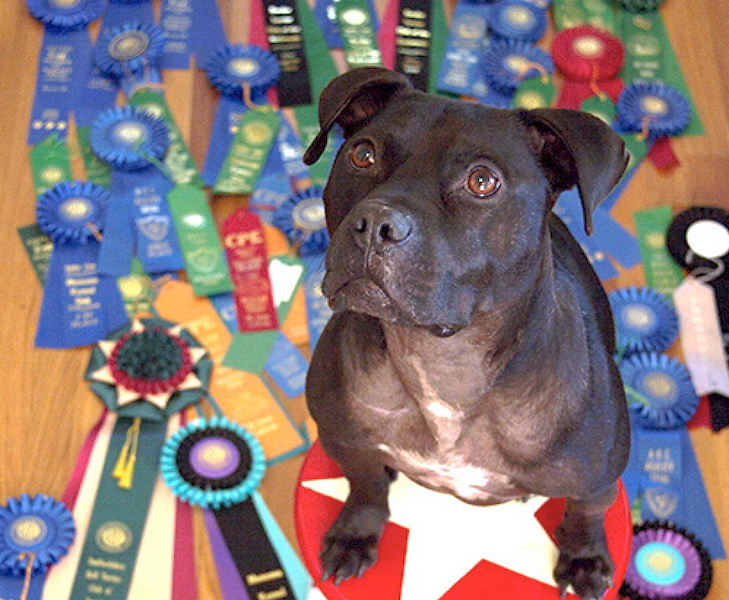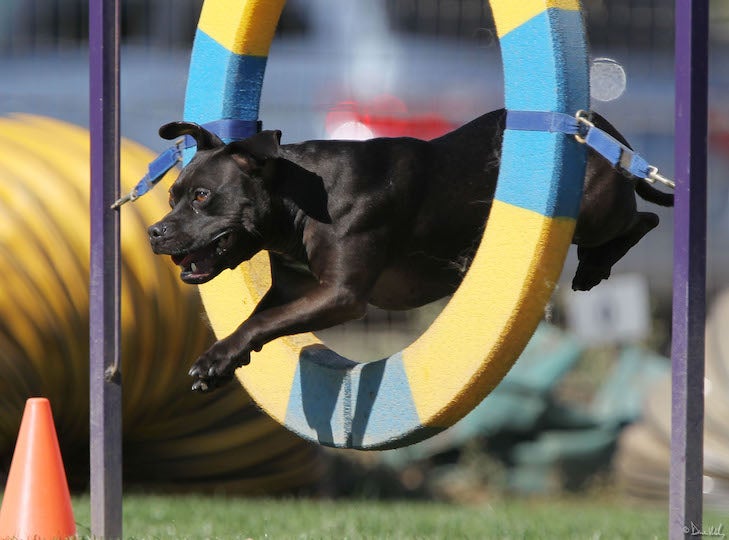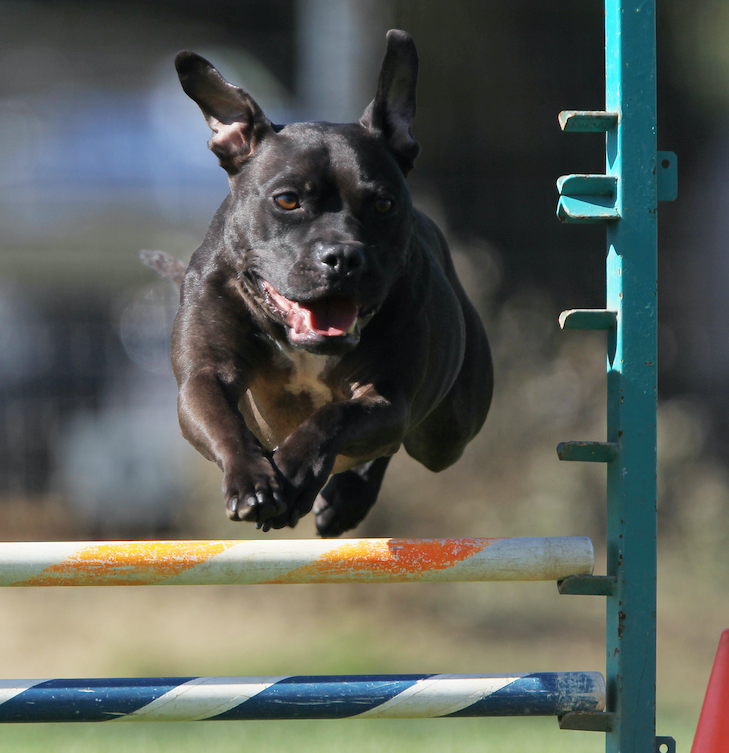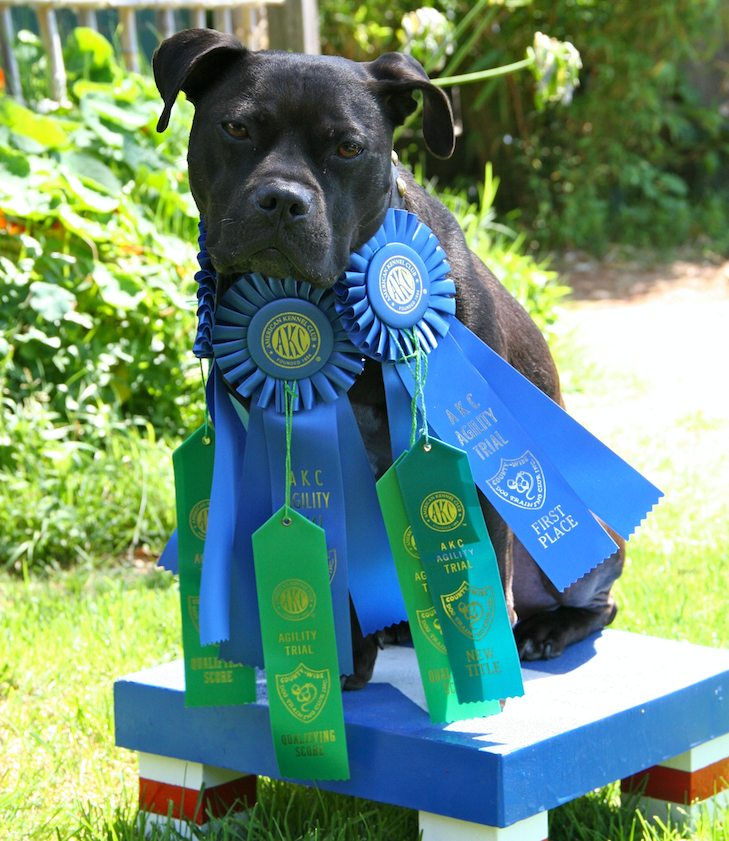
Vicktory Over Adversity
Seeing Audie, tail wagging as he greeted a group of children, it was hard to believe that he once cowered at the sight of a human hand.
Watching Audie, as he zipped and weaved from tunnel to tire in a noisy agility ring, it was hard to believe that he once fled in terror at the sound of a bark.
Admiring Audie, sitting tall on a podium, proudly wearing a necklace of blue rosettes, it was impossible to believe that he once faced a short, grim life and violent death as a fighting dog in the infamous Bad Newz Kennels.
Audie was a “Vick dog.”
That he made it out alive at all is a triumph, but what he achieved in the years after leaving that deadly kennel was nothing short of a miracle.
Many dogs from NFL player Michael Vick’s dogfighting kennel eventually made good on the outside, passing AKC Canine Good Citizen tests, working as therapy dogs, and becoming great pets and ambassadors for pitbulls.
Audie, a black Staffordshire Bull Terrier, sailed over an even higher bar into competitive agility, a busy, boisterous sport that requires speed, smarts, focus, and a bombproof temperament.

Death’s Door
When 49 dogs were seized from the notorious Virginia kennel, it was assumed they were all doomed. Their survival was largely due to efforts of a small group of dedicated rescuers, including BAD RAP, a nonprofit organization dedicated to helping pit bulls. These trainers, behaviorists, and volunteers begged for the dogs’ lives, and for a chance to disprove the notion that it was foolhardy to try to rehabilitate dogs who had been trained to fight.
After temperament tests, only one of the Bad Newz dogs was deemed beyond hope, and euthanized. Others were too fearful for normal homes, so animal sanctuaries agreed to take them in. 25 dogs were deemed stable enough to go to foster homes, and perhaps, one day, to become pets. Audie was among them.
At the time of the April 2007 seizure from Vick, the pup had just a number—Chesapeake 54902. Along with the other dogs, he had spent five months isolated, with bare necessities like food and water, but scant human contact.
Once legal issues were resolved, BAD RAP volunteers drove the pup to his first foster home, where he got a name, Dutch, and proceeded to impress his caretakers with his energy.
The fosters realized that Dutch had the raw material to be a great agility dog. As fate would have it, their friend Linda Chwistek was looking for a new agility partner, and she possessed the perfect combination of sensitivity, experience, and skill to polish this rough gem. By age 8, Chwistek and her Cocker Spaniel had already joined a training club. In the years since, she’d racked up a half-century of dog-training experience, with a decade devoted specifically to training shelter dogs.
In 2008, just a year after being saved, the energetic pup found a new home with Chwistek and her husband. He also had a new name, Audie, after another little guy with outsized courage—World War II hero Audie Murphy.
Audie had a lot of great qualities, but there were also huge challenges if he was ever to set foot on an agility course. So, Chwistek mapped out a training program.
A Kind Cut
Like all the Vick dogs, Audie had little socialization during the critical learning period of 3 to 12 weeks old. In that time, Audie knew only loneliness, violence, and terror, leaving him with emotional scars, no manners, and a slew of bizarre habits. He didn’t know how to walk up stairs, and he ate everything in sight, even cigarette butts. Once, he wolfed down a sock, requiring emergency surgery.
Ironically, another episode under the surgeon’s knife turned out to be a blessing in disguise. Soon after Audie came home with her, Chwistek noticed that he was limping. The diagnosis was luxating patellas on both hind legs. It seemed that his future in agility was dim, but Chwistek found a surgeon who could correct the problem, so she took the chance on the operation, which was paid for by funds from Vick’s settlement.
This detour, especially the months of confinement, allowed her to focus on filling in some blanks in Audie’s education. He learned basic commands within this small nonthreatening world, and once his knees healed and he was back on his feet, it was time to broaden his horizons.
Oh, Brave New World
An ideal spot for easing Audie’s fear of humans was the waterfront in Chwistek’s town of Vajello, where large groups of commuters would gather to catch ferries across the bay to San Francisco.
“Initially, he was just terrified of them,” Chwistek recalls. “So I sat on a bench, far, far away. Over the course of a couple of years, I kept moving closer and closer to the commuters.”
Slowly, Audie grew accustomed to the comings and goings of strangers. He started to make friends, especially among the retirees strolling along the waterfront. Among the first to win his trust was a newspaper vendor who offered treats. Audie wanted the cookies, but he was too afraid to walk up and take them. Instead, he’d crawl on his belly, getting just close enough to snatch the treat, before swiftly withdrawing.
“It took a good six months for him not to be terrified,” Chwistek says.
Strange dogs also scared him, and this fear posed serious challenges when the team started agility training, as he seemed unable to differentiate between playful and aggressive barking. Normal sounds of dogs playing so unnerved him during his first agility classes that he’d often bolt from the course and seek refuge in his crate or the car.
“I almost quit agility because I didn’t think it was fair to him. I didn’t think he enjoyed it,” Chwistek recalls.

Chwistek’s classmates refused to let her give up, though, and did whatever it took to keep Audie on track, even agreeing to conceal their dogs behind makeshift blinds during Audie’s turns on the floor. Little by little, Audie became more comfortable, and the dogs emerged from behind the blind. Soon, Audie tuned out other dogs and zeroed in on his handler and the obstacles.
After two years of steady work, Audie had achieved the confidence to remain calm amid the cacophony of an agility trial. Chwistek enrolled him in the AKC Purebred Alternative Listing program as a Staffordshire Bull Terrier, and so began his competitive career. Beyond his CGC and agility ribbons, Audie also earned himself a title in Scent Work.
A Life Well-Lived
Audie’s life following his years as a Vick dog was celebrated in the 2011 children’s book Saving Audie. The superlative Staffie finished his dog sport career with a multitude of titles to his name, and served as an inspiration to nearly everyone he met. Audie eventually grew old and passed away peacefully in 2017, but he will forever be remembered by those who had the chance to meet this determined dogfighting survivor.

This article, which first appeared in the January/February 2013 issue of AKC Family Dog magazine, won the 2014 Dog Writers Association of America award for Best Magazine Feature/Behavior and Training. After this story ran, Audie earned one of the highest agility honors a dog can have—Preferred Agility Champion. By the time he died in 2017, he had an impressive array of titles: PACH Audie MXP4, MXPB, MJP5, MJPS, PAX, T2BP.


